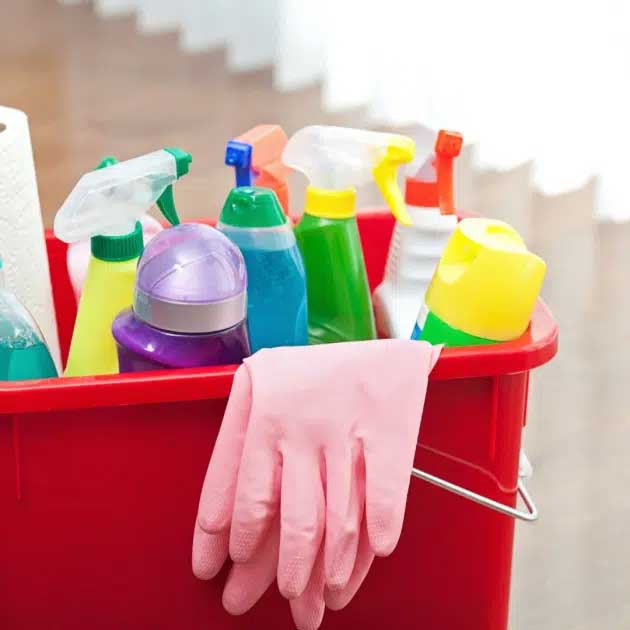INTRODUCTION
Finding non-toxic or less toxic cleaning products is super important because we often not only touch them but inhale them as well! Many options on the market today are better for you and making your own can be fun and cost-effective if you have the time.
Don’t forget to be patient because this process can involve trial and error to find new products and methods that meet your personal cleaning standards.
For all of those listed below, look for options that are powered by plant enzymes and free of harsh chemicals, solvents, synthetic fragrances, dyes, ammonia, and chlorine bleach.
TOXIC CLEANING PRODUCTS

Pay close attention to the products you use most often. Products like:
- Dishwasher detergent or dishwashing liquid – this choice is critical if you don’t wear gloves while washing the dishes
- Disinfecting and cleaning sprays for countertops, tubs, and showers.
- Laundry detergent
- Fabric softener/dryer sheets
Remember that fabric softeners and dryer sheets will be coming into contact with your skin when wearing the clothes and using the towels that are coated in them! A better option may be to try adding ½ cup distilled white vinegar to the final rinse or fabric softener dispenser to brighten, kill odors, and soften clothes.
Try using the distilled white vinegar with a drop of lavender essential oil to add a nice smell to your laundry. Wool dryer balls are another easy way to soften clothes plus they reduce static and cut drying time by 25%!
Also, don’t forget about things you use to clean and freshen the air in your home like:
- Candles – candles made from paraffin wax create highly toxic compounds like benzene and toluene (both known carcinogens) and release them into your indoor air. In addition, candle wicks can contain a lead core. So opt for beeswax (the best), coconut oil (better), and soy candles (good) with lead-free, cotton, wood, or hemp wicks. If you enjoy a scented candle look for brands that use natural botanicals and essential oils. But be aware that candle companies are allowed to use 4000 different chemicals and put them under the label of “fragrance” or “parfum”. Sneaky!!
- Sprays or Plug-ins – opt for those responsibly sourced and formulated with essential oils. Many essential oils have anti-bacterial, anti-fungal, and anti-viral properties. Alternatives like a bowl of natural potpourri made from dried flowers, fragrant herbs, and essential oils, or fresh flowers can be used instead.
LAWN CARE PRODUCTS
In this category, we need to consider the products we use to grow and kill things. For all of those listed below, think about what you are currently using and if there is a method that will still work but wouldn’t increase your exposure (or animals) to harmful chemicals.
- Fertilizers
- Herbicides – instead of a glyphosate-based product, try this DIY method to kill weeds:
- Pour 1 gallon of white vinegar into a bucket.
- Add 1 cup of table salt and stir to dissolve.
- Add 1 Tbsp Dawn blue dishwashing liquid and stir.
- Funnel into a spray bottle or garden sprayer.
- Drench the weeds with the mixture on a hot sunny day.
- Watch the weeks die in a few days.
- Pesticides & Insecticides – you can find less toxic options at your local hardware store for DIY but if you hire a pest control company, ask what products they use and ask to see the material safety data sheet (MSDS) before allowing application and avoid inside applications. Ask if they have a “green/organic” option available. Many people report good success with an essential oil-based product called EcoVia.
- Car and deck/porch cleaning
CONCLUSION
Think about what will be touching your skin most often and what is most likely to compromise your indoor air quality. Consider upgrades when necessary, do a bit of research, and have a curious mind before investing in new items. Companies that are eco-conscious will often give detailed info about their products on their websites.
To learn more about embracing a toxic-free lifestyle, download my free Personal Care, Cleaning, and Textiles Guide. You’ll be glad you did. Also, if you have any questions about toxic cleaning products, email me and I’ll be happy to answer them.
***Disclaimer: This post is for informational purposes only and should not be construed as medical advice***

